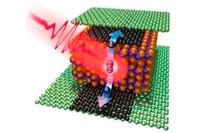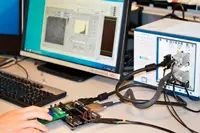Electronics News
Archive : 9 October 2015 год
 A research group led by Professor Frank Koppens from the Institute of Photonic Sciences (ICFO) has shown that a two-dimensional crystal, combined with graphene, has the capability to detect optical pulses with a response faster than 10ps.
A research group led by Professor Frank Koppens from the Institute of Photonic Sciences (ICFO) has shown that a two-dimensional crystal, combined with graphene, has the capability to detect optical pulses with a response faster than 10ps.
Ultra-fast detection of light lies at the heart of optical communication systems. Driven by the IoT and 5G, data communication bandwidth is growing exponentially, thus requiring even faster optical detectors that can be integrated into photonic circuits.
An important advantage of these devices based on graphene and other two-dimensional materials is that they can be integrated monolithically with silicon photonics enabling a new class of photonic integrated circuits. The next step is to develop prototype photonic circuitry and explore ways to improve large-scale production of these devices.
ICFO researcher Mathieu Massicotte said: "Everyone knew graphene could make ultra-fast photodetectors, but related two-dimensional crystals were still lagging very much behind. In our work we show that by teaming up these two materials, we can obtain a photodetector that is not only ultrafast but also highly efficient."
Author
Tom Austin-Morgan
Source: www.newelectronics.co.uk
 National Instruments (NI) has announced the shortlist of finalists for its 2015 Engineering Impact Awards, which honour Northern Europe’s most innovative engineering projects using NI software and hardware.
National Instruments (NI) has announced the shortlist of finalists for its 2015 Engineering Impact Awards, which honour Northern Europe’s most innovative engineering projects using NI software and hardware.
The finalists in this year’s Engineering Impact Awards have combined their expertise with NI tools, in order to solve challenging engineering problems.
This year’s finalists include Quantum Detectors that has used LabVIEW and FlexRIO to reduce development time of a high-speed X-ray imaging system. ON Semiconductor and Fingerprint Cards AB go head-to-head in the Electronics Test and Measurement category. ON Semiconductor has developed mixed-signal automated test equipment production tester for its new generation image sensors. Fingerprint Cards has created a validation system for fingerprint identification chips in mobile devices.
In the Internet of Things category, TBG Solutions has used Single-Board RIO and LabVIEW to develop a network of smart devices to monitor household energy efficiency. A team from National Grid UK has adopted a platform based on CompactRIO to analyse large amounts of data from the grid to adapt the efficiency of the grid as renewable energy supplements fossil fuel usage over time.
In the Student Design Competition the University of Leeds has entered a team that has developed a haptic simulator with augmented reality visual feedback for medical training using MyRIO and LabVIEW to simulate needle insertion in lumbar puncture procedures or laparoscopic surgery.
Winners will be announced at the Engineering Impact Awards ceremony, held at The Royal Academy of Engineering, London, on Monday 2nd November. Several finalists will also present their applications in technical sessions at the NIDays conference the following day.
Pic: Fingerprint Cards AB has created a validation system for fingerprint identification chips in mobile devices
Author
Tom Austin-Morgan
Source: www.newelectronics.co.uk
 Continental is expanding its automotive expertise to smart street lighting. After oil lamps, gas lamps, and electric street lights, LED street lights are the next step towards a lower energy, connected lighting system. Continental says that, in addition to energy savings of around one third, LEDs require less maintenance reducing costs further.
Continental is expanding its automotive expertise to smart street lighting. After oil lamps, gas lamps, and electric street lights, LED street lights are the next step towards a lower energy, connected lighting system. Continental says that, in addition to energy savings of around one third, LEDs require less maintenance reducing costs further.
The automotive supplier says its street lights have the potential to improve road safety and convenience thanks to the inclusion of electronics and sensors. Alfred Waldhaeusl, coordinating the project at Continental, said: “The use of LEDs means that the electronics required for control, diagnostics, and communication are already present in the street lights.”
Waldhaeusl explained: “Sensors enable us to identify whether parking spaces in the vicinity of the light are occupied. We can then provide this information either directly or via a cloud to drivers who are looking for a parking space nearby. This way we improve parking management, revenues, and the CO2 footprint of municipalities.”
According to Waldhaeusl, moving objects can also be detected and brightness could therefore be adjusted to match requirements, depending on whether a pedestrian, cyclist, or car is approaching, or the light could even be switched off entirely. Accidents could also be identified, the emergency services alerted and following vehicles could be warned.
Intelligent street light control could also play a key role in automated driving. Additional elements include recording environmental factors such as brightness, temperature, rain, snow, and the formation of ice. LED street lights could also be equipped with charging stations for electric vehicles.
Continental anticipates a range of different versions. Basic LED street lights will provide light only, although they will still require an electronic LED driver to do so. At the next level, LED street lights will include diagnostic functions and therefore automatically provide a communication channel. At stage three, smart features will be added.
Some of these intelligent LED street lights are already in use on the streets of Toulouse. The French city is now enabling Continental to carry out the first field tests in an actual city environment.
Waldhaeusl concluded: “Based on normal service life [of electric street lights], within 15 to 20 years almost all street lights will be LED.”
Pic: The Continental control module helps to recognise whether a car, person or bike passes by. The light adapts accordingly.
Author
Tom Austin-Morgan
Source: www.newelectronics.co.uk
 Scientists at the University of British Columbia have discovered that electronic properties at the edges of organic molecular systems differ from the rest of the material and say this could enable cheaper, more efficient devices.
Scientists at the University of British Columbia have discovered that electronic properties at the edges of organic molecular systems differ from the rest of the material and say this could enable cheaper, more efficient devices.
“We found that polarisation induced energy level shifts from the edge of these materials to the interior are significant and can’t be neglected when designing components,” said researcher Katherine Cochrane.
The researchers looked at ‘nano islands’ of clustered organic molecules deposited on a silver crystal coated with a layer of salt just two atoms deep. The salt prevents electrons in the organic molecules from interacting with those in the silver.
Not only did the molecules at the edge of the nano islands have different properties than in the middle, the variation in properties depended on the position and orientation of nearby molecules.
“While we were expecting some differences, we were surprised by the size of the effect and that it occurred on the scale of a single molecule,” added assistant professor Sarah Burke, an expert on nanoscale electronic and optoelectronic materials.
“Herbert Kroemer said in his Nobel Lecture that ‘The interface is the device’ and it’s equally true for organic materials,” she continued. “The differences we’ve seen at the edges of molecular clusters highlights one effect that we’ll need to consider as we design new materials for these devices, but it’s likely there are many more surprises waiting to be discovered.”
Pic: From the left, Sarah Burke, Katherine Cochrane and Tanya Roussy
Author
Graham Pitcher
Source: www.newelectronics.co.uk

